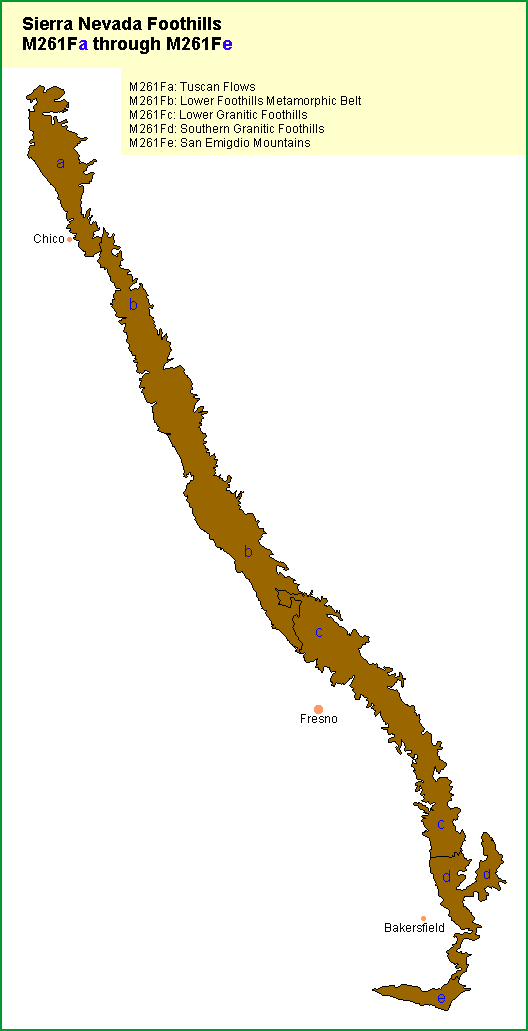Section M261F
Sierra Nevada Foothills
![]() This
section comprises the hot foothills of the Sierra Nevada, and the southwestern
end of the Cascade Ranges, adjacent to the Great Valley. Summers
are hot and dry and winters are mild. MLRA 18.
This
section comprises the hot foothills of the Sierra Nevada, and the southwestern
end of the Cascade Ranges, adjacent to the Great Valley. Summers
are hot and dry and winters are mild. MLRA 18.
Geomorphology. Block mountain range tilted west; accordant
crests. Sierra Nevada Range geomorphic province.
Lithology. Mesozoic sedimentary, granitic, volcanic and ultramafic
rocks.
Soil Taxa. Alfisols, Aridisols, Entisols, Inceptisols, Mollisols and Vertisols in combination with mostly thermic soil temperature regimes and xeric or aridic soil moisture regimes.
Vegetation. Predominant potential natural communities include the Blue oak series, Needlegrass grasslands, Chamise series, Mixed chaparral series, Foothill pine series and Valley oak series.
The following series are found throughout the section and are not restricted to or extensive in any subsection. Series dominated by exotic plants are not listed under subsections unless they are extensive and stable.
-
Series dominated by exotic plants: Broom series, California
annual grassland series, Cheatgrass series, Gaint reed series, Introduced
perennial grassland series, Kentucky bluegrass series and Tamarisk series.
Series that can occur in all subsections, but are not extensive: Bulrush series, Bulrush - cattail series, Cattail series, Common reed series, Deerbrush series, Duckweed series, Mosquito fern series, One-sided bluegrass series, Pondweeds with floating leaves series, Pondweeds with submerged leaves series, Purple needlegrass series, Quillwort series, Sedge series, Spikerush series and Tufted hairgrass series, .
Series restricted to riparian settings: Arroyo willow series, Black willow series, Buttonbush series, California sycamore series, Fremont cottonwood series, Mixed willow series, Narrowleaf willow series, Mulefat series, Pacific willow series, Red willow series and White alder series.
Elevation. 200 to 5000 feet.
Precipitation. 8 to 40 inches.
Temperature. 45° to 64°F.
Growing Season. 150 to 300 days.
Surface Water Characteristics. Many rapid flowing rivers and streams. Rivers flow westerly in deeply incised canyons with bedrock controlled channels to the Great Valley section and Pacific Ocean. Reservoirs for municipal water supply, irrigation and flood control are common.
Disturbance Regimes.
- Fire: Fires are low, moderate and high intensity surface or
stand replacing fires.
Cultural Ecology. Humans have been utilizing the section for about 10,000 years, and have been an integral part of its ecology for 3,000 to 5,000 years. Sierran foothills contain some of the densest year-round prehistoric habitation locations in California, particularly along riparian areas, where intensive occupation, resource procurement and processing practices, and vegetation manipulation ofttimes altered the environment. Contemporary attitudes tend to be dichotomized between amenity/newcomer and commodity/long-time resident values. Human environment is characterized by a rural lifestyle of open space and out-door leisure activity. Recreation is the primary economic emphasis, trailed by government employment. The foothills, in particular, are experiencing rapid retiree and commuter resident growth.
Subsections. The Sierra Nevada Foothills section is divided
into 5 subsections.
To obtain information about a particular subsection, click the subsection.
